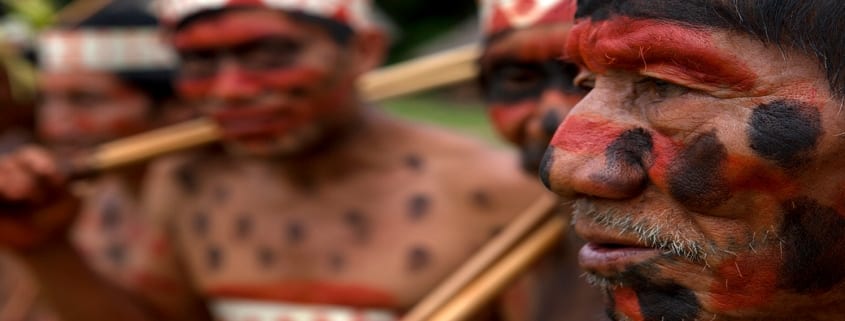2017 Regional Overview: Latin America
From protecting rediscovered species in Brazil to securing rare magnolias in the Andes of Colombia, in 2017 Rainforest Trust supported local partners to preserve over 88,300 acres of habitat across Latin America.
Rainforest Trust and its local partner helped 16 indigenous communities in Peru gain titles to their lands, totaling more than 428,815 acres over the past few years. This is part of a larger effort to title over 50 community territories that will form a firewall against colonization around the Sierra del Divisor National Park and the soon-to-be White Sands National Reserve. Together, these two parks and the surrounding community lands will span almost 6 million acres. Rainforest Trust’s partner is helping these communities create sustainable management plans for their communal properties which are rich in rare and threatened species, including 38 mammals such as Jaguars, South American Tapirs and Red Uakari Monkeys. There are also believed to be 3,500 plant species, 300 fish species, 365 bird species and 109 amphibian species in this irreplaceable region.
In one of the world’s most biodiverse tropical savannas, the Cerrado biome of Brazil, Rainforest Trust worked to create the first protection for the rediscovered Endangered Kaempfer’s Woodpecker. Originally discovered 80 years ago, the red-crested Kaempfer’s Woodpecker was thought to be extinct until it was rediscovered in the region in 2006. Rainforest Trust’s local partner purchased the 593-acre private property, and the new reserve will be registered with the state as a private nature reserve (RPPN) to add an extra layer of protection. This will serve as an example for other landowners interested in establishing reserves on their own properties in the future. In addition to purchasing this key property and establishing an RPPN, the partner’s long-term goal is to launch a landscape-scale initiative to work with landowners to establish a network of private reserves across approximately 5,000 acres.
In the most rapidly disappearing habitat in Brazil, Rainforest Trust teamed up with its local partner Sociedade para a Conservação das Aves do Brasil (SAVE Brasil) to purchase the unique cerrado habitat (a type of highly threatened Brazilian savanna) and provide protection for the recently rediscovered Blue-eyed Ground-dove.
Across Ecuador, Rainforest Trust worked with its local partner to expand reserves and provide vital protection for key plant and animal species. The Rio Canandé Reserve is a hotspot for biodiversity, and many species with restricted ranges depend on the reserve’s lowland tropical rainforests, including the Critically Endangered Canandé Magnolia – documented only at this reserve – and the Critically Endangered Brown-headed Spider Monkey, one of the world’s rarest primates. In addition, at least 36 Endangered Great Green Macaws inhabit the area, perhaps the largest known group in Ecuador. It is immensely important that this area is protected from nearby palm oil and logging concessions. The conservation groups also purchased new properties totaling over 345 acres to add to the Narupa Reserve in northeast Ecuador, one of the most biodiverse areas in the world. Just north of the Narupa Reserve, 872 species of birds have been recorded in the Sumaco-Napo-Galeras National Park, exemplifying the importance of this habitat. The new protected area provides critical habitat for range-restricted Andean endemic bird species and Vulnerable Neotropical-Nearctic migrant bird species, especially the Cerulean Warbler. This expansion also includes important habitat for at least four species of Endangered amphibians, including the Puyo Giant Glass Frog.
An additional land purchase of 126 acres through a local partnership brought the Río Zuñac Reserve’s total size to over 2,400 acres, protecting pristine cloud forest, endangered and range-restricted orchids and other threatened species. Because of the high rainfall and unusual geology, the reserve is rich in endangered, range-restricted plant species, 20 of which are found nowhere else in the world. In addition, the reserve harbors other Endangered species such as Black-and-chestnut Eagles and Mountain Tapirs, as well as Spectacled Bears and a highland population of Woolly Monkeys.
[crb_slider][crb_slide image=”https://legacy.rainforesttrust.org/wp-content/uploads/2017/12/Mark-Wilson-Zunac-Eagle-Prey-.png” credits=”An Endangered Black-and-chestnut Eagle pair feasting in their nest in Río Zuñac Reserve. Photo by Mark Wilson” title=”” text=””][/crb_slider]
In Panama, Rainforest Trust worked with a local partner to expand the Cerro Chucantí Nature Reserve by 260 acres with a long-term aim of creating a broader government designated protected area. Titled properties were purchased to help establish an important buffer zone that acts as a barrier to prevent squatters from moving into extensive public wilderness areas, and will discourage poachers from hunting in the vicinity. The land purchase is part of the very limited high elevation cloud forest where many new species have been discovered, such as the dark brown Chucantí Salamander (Bolitoglossa chucantiensis) and the Maje Dink Frog (Diasporus majeensis sp. nov.). There are still a few species of snakes, at least three frog species, one salamander species and over a dozen species of ants and plants awaiting formal description.
In Colombia, Rainforest Trust and its partner expanded the Selva de Ventanas Natural Reserve by 120 acres. This is a vital component of the strategic network of biological corridors being created to connect remaining forest fragments. This expansion contains 32 percent of the global population of the Ventanas Magnolia (Magnolia polyhypsophylla), the most endangered tree species in the region with only 25 adult individuals known in the world.
In Guatemala, Rainforest Trust helped its local partner purchase six properties totaling 995 acres to establish the Cerro Amay-Chimel Cloud Forest Preserve. The Cerro Amay Cloud Forest is among the largest areas of intact forest left in Central America. Together, Rainforest Trust and its partner are strategically purchasing properties to connect the entire network for a corridor of protection while attracting researchers, promoting ecotourism and implementing sustainability initiatives in the indigenous villages surrounding the Cerro.
Thank you to the generous support of our friends around the world and the SAVES Challenge, for making these projects a success.
For more information on how you can support Rainforest Trust, visit our Conservation Action Fund.




